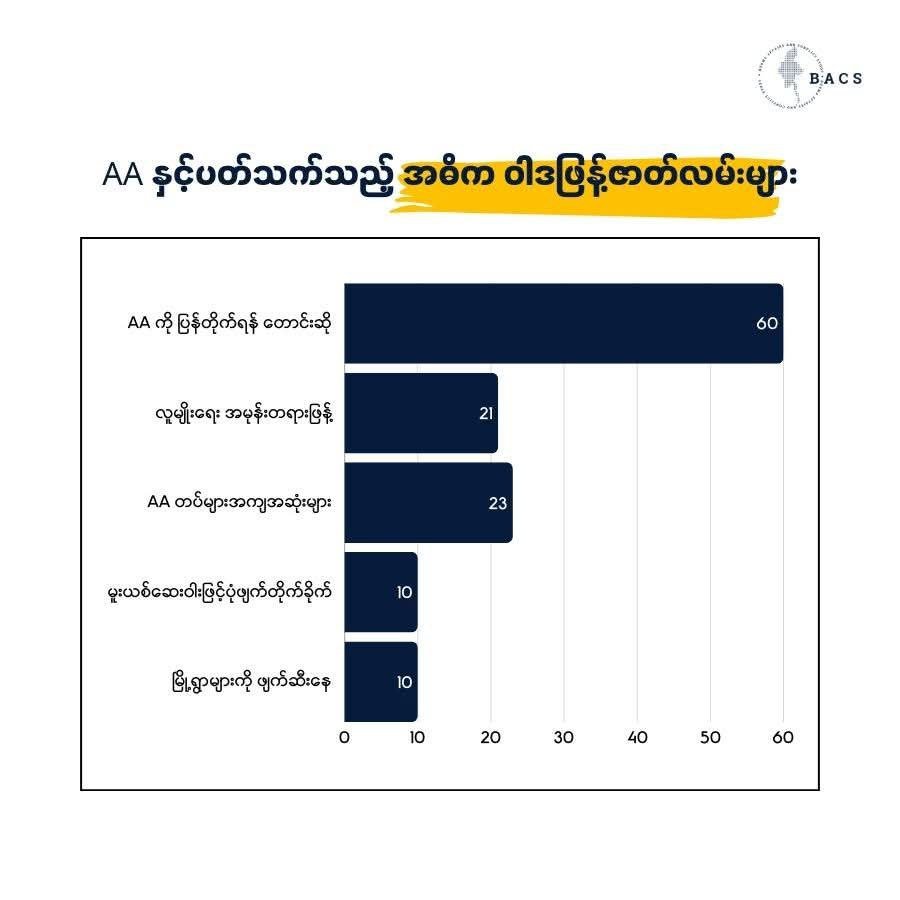Monitoring and research groups report that the Myanmar military council’s forces are intensifying their propaganda campaigns targ eting the Arakan Army (AA).
The Myanmar Conflict Research Group reported today, December 29, that the Myanmar military council’s lobbyists intensified their propaganda campaigns against the Arakan Army (AA) during the decisive phase of the Arakan conflict, particularly between December 7 and 20.
It is reported that targeted disinformation campaigns were prim arily conducted against the Arakan Army (AA).
It is also reported that back in February, there was a surge in racial hate propaganda targeting the Arakan Army (AA) and the Rakhine people. During the battles to capture towns in the Arakan region, the military council’s lobbyists attempted to counter with racial incitement and disinformation campaigns.
It is reported that during the two-week period, including the battle to capture the Western Command headquarters and other town offensives, a total of 120 propaganda posts related to the Arakan Army (AA) were disseminated.
Initially, the military council’s lobbyists spread propaganda claiming that the Western Command headquarters had not been seized. However, similar to the town offensives during Operation 1027, when the Arakan Army (AA) released information and evidence through their statements, it further discredited and embarrassed the military council’s claims.
As a result, it is reported that among the propaganda narratives, there were around 60 posts claiming plans to recapture the Wes tern Command headquarters and other towns seized by the Arakan Army (AA) as part of efforts to discredit them.
Among these, the majority were posts inciting racial hatred. Over 20 propaganda posts reportedly spread narratives alleging that the Arakan Army (AA) was executing captured military personnel and oppressing Rohingya communities, aiming to discredit the AA further.
Over the past three months, military council lobbyists spread prop aganda claiming that 2,500 Arakan Army (AA) members had been killed. However, when the AA released images and evidence showing the ground situation of the captured Border Guard Police Battalion (No. 5) base and the Western Command headquarters, it reportedly deterred further propaganda efforts by these lobbyists.
During previous observation periods, posts predominantly focused on narratives of heavy losses, defeats, and destruction were freq uently encountered. However, in the past two weeks, it is reported that such posts have decreased to around 20.
It is reported that the most intense propaganda campaigns against the Arakan Army (AA) were carried out. Additionally, propaganda efforts were also directed towards the Kachin Independence Army (KIA), aiming to discredit them, particularly as battles intensified in Bhamo and Mansi.
It is reported that the propaganda methods related to the military council’s armed forces have evolved based on the intensity of gro und warfare and political circumstances.
It is reported that while previously the TNLA and MNDAA were the primary targets of propaganda by the military council’s lobbyists, focusing on them as key subjects in their narratives, it is now obser ved that the Arakan Army (AA) and the Kachin Independence Army (KIA) have become the main subjects of these propaganda campaigns.
In the decisive phase of the Arakan conflict, the Arakan Army (AA) has taken control over the entire Arakan region, including the Palet wa area, extending to 14 townships. They have also blocked the towns of Sittwe, Kyaukphyu, and Manaung.
As a result, it is expected that in the decisive phase of the Arakan conflict, while the military council’s forces will inevitably continue their bloodshed propaganda campaigns, military council lobbyists are likely to persist in spreading racial and religious divisive propa ganda. This assessment has been made by those who monitor and study the military’s propaganda efforts.






